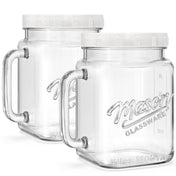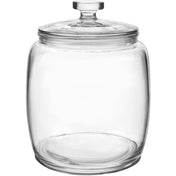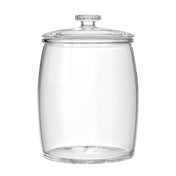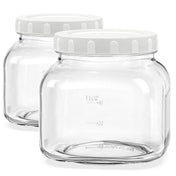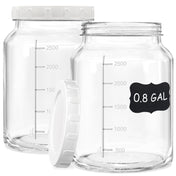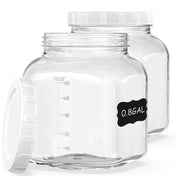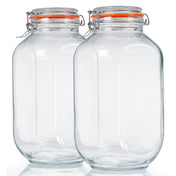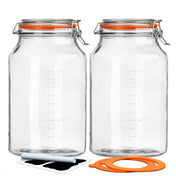In the average American kitchen, plastic is everywhere—think of the 50+ plastic items cluttering your pantry, from flimsy storage containers to single-use bags. But here’s the catch: these everyday plastics might be silently harming your health and the planet. With growing awareness of sustainability, many are turning to a simple yet stylish solution: glass jars. These versatile, non-toxic, and recyclable heroes are more than just storage—they’re a step toward a greener lifestyle. In this guide, we’ll walk you through practical ways to use glass jars to build an eco-friendly kitchen while cutting back on plastic dependency. Ready to make the switch? Let’s dive in!
Why Choose Glass Jars? The Hidden Dangers of Plastic Storage
Plastic might be convenient, but it comes with a steep environmental and health cost. Here’s why glass jars are winning over American households—and why you should consider them too.
The Environmental and Health Impact of Plastic
The numbers don’t lie: in 2021, the U.S. generated about 40 million tons of plastic waste, yet only 5-6% (roughly 2-2.4 million tons) was recycled, according to Smithsonian Magazine (2022). That means 85% ended up in landfills, and 10% was incinerated, leaving a massive environmental footprint (source). Compare that to 2018, when the EPA reported 35.7 million tons of plastic waste with an 8.7% recycling rate—by 2021, things only got worse (EPA Plastics Data).
Beyond the landfill crisis, plastic poses health risks. The FDA warns that chemicals like BPA (bisphenol A) and phthalates in plastic can leach into food, potentially disrupting hormones and causing long-term harm (FDA BPA Safety). Plus, plastic waste contributes to ocean pollution—about 10 million tons of it ends up in our seas each year, breaking down into microplastics that threaten marine life and human health (The Roundup, 2024, source).

Glass vs. Plastic: A Carbon Footprint Breakdown
Sure, making glass jars requires more energy upfront—melting glass at 1500°C produces about 2.5 kg of CO2 per liter-sized jar, compared to 1.5 kg for a plastic one (Hedgehog Company, 2022, source). But here’s the game-changer: glass jars can be reused. Use one five times, and its per-use carbon footprint drops to 0.5 kg—less than plastic’s one-and-done 1.5 kg. Keep reusing it (say, 10 times), and the savings stack up, making glass a smarter long-term choice for eco-conscious families.

Glass Recycling and Sustainability
Glass shines in the recycling game too. The EPA pegs the U.S. glass container recycling rate at 31.3% in 2018, with estimates suggesting it’s climbed to 33% in recent years, thanks to improved systems and awareness (EPA Glass Data, source; Glass Packaging Institute, source). Unlike plastic, glass is 100% recyclable without losing quality, fitting perfectly into the “minimalist kitchen” trend sweeping American homes.
Why Glass Jars Win
Glass jars offer a triple threat: no chemical leaching, endless reusability, and full recyclability. Americans love them for being food-safe and sustainable—values that resonate in today’s health- and planet-focused culture.
5 Practical Steps to Build an Eco-Friendly Kitchen with Glass Jars
Ready to ditch plastic and go green? Here are five easy ways to transform your kitchen with glass jars, tailored to American lifestyles.
-
Swap Plastic Containers for Dry Goods Storage Say goodbye to plastic bins and hello to glass jars for storing grains, flour, nuts, or snacks. They keep food fresh longer and eliminate the risk of plastic contamination. Bonus: brands like Syntic Jars are a pantry staple in U.S. homes for a reason—they’re reliable and timeless.

-
Make Eco-Friendly Pickles and Preserves Glass jars are perfect for homemade pickles or jams—think Thanksgiving prep or summer fruit preserves. It’s a tradition many American families cherish, and the airtight seal keeps flavors locked in without plastic’s downsides.

-
Cut Down on Single-Use Plastic Bags Toss those Ziplocs! Use small glass jars to pack snacks or leftovers for work or school. They’re portable, reusable, and way better for the planet—ideal for busy parents or on-the-go professionals.

-
Create a Tidy, Open-Shelf Look Glass jars’ transparency makes them a dream for organizing spices, coffee beans, or pasta. Line them up on open shelves for that “farmhouse style” vibe that’s all over Pinterest and HGTV—functional and Instagram-worthy.

-
Upgrade Your Drink Game Ditch plastic water bottles and whip up cold brew coffee or fruit-infused water in a glass jar. It’s a healthier, trendier choice that aligns with America’s love for clean eating and sustainable sipping.

How to Get Started—Choosing the Right Glass Jar
Not all glass jars are created equal. Here’s how to pick the perfect ones for your eco-friendly kitchen.
- Material and Design Tips Go for durable options like Syntic’s glass jars, featuring secure clasp lids or classic screw tops. These designs ensure a tight seal—perfect for everything from pantry staples to preserves—and they’re built to last.
- Size Matters Small jars (8-12 oz) are great for spices or snacks, while larger ones (64 oz) handle bulk storage like grains or flour. Mix and match based on your needs—versatility is key.
- Where to Buy Check out Syntic’s website for a range of multi-size, multi-purpose glass jars. Whether you’re stocking up for the week or gifting a homemade treat, we’ve got you covered with sustainable style.


Switching to glass jars isn’t just about decluttering your kitchen—it’s a win for your health, the environment, and your home’s vibe. By replacing plastic with these reusable, recyclable gems, you’re cutting waste, avoiding harmful chemicals, and embracing a lifestyle Americans are raving about. Start small: swap out one plastic container today and see the difference. Want to explore our top picks? Click here to shop Syntic’s glass jar collection and kick off your eco-friendly journey!
For more tips, recipes, and creative ideas on using your Syntic glass jar, visit the Syntic Blog—where timeless design meets everyday functionality, making storage and serving a delight. ✨


